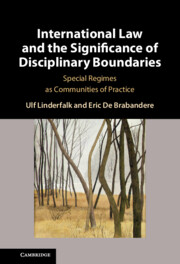 International Law and the Significance of Disciplinary Boundaries
International Law and the Significance of Disciplinary Boundaries Book contents
- International Law and the Significance of Disciplinary Boundaries
- International Law and the Significance of Disciplinary Boundaries
- Copyright page
- Contents
- Author Notes
- Abbreviations
- 1 The Concept of a Special Regime
- 2 Special Regimes as Communities of Practice
- 3 A Mutual Engagement
- 4 A Joint Enterprise
- 5 A Shared Repertoire
- 6 Special Regimes and the Fragmentation of International Law
- List of Sources
- Index
4 - A Joint Enterprise
Published online by Cambridge University Press: 21 November 2024
- International Law and the Significance of Disciplinary Boundaries
- International Law and the Significance of Disciplinary Boundaries
- Copyright page
- Contents
- Author Notes
- Abbreviations
- 1 The Concept of a Special Regime
- 2 Special Regimes as Communities of Practice
- 3 A Mutual Engagement
- 4 A Joint Enterprise
- 5 A Shared Repertoire
- 6 Special Regimes and the Fragmentation of International Law
- List of Sources
- Index
Summary
This chapter addresses the suggestion that for a special regime to exist, community members must be engaged in a joint enterprise. In the context of international law, to claim that a group of international law specialists is engaged in a joint enterprise is to assert that they do what they do based on the idea that some certain state of affairs is desirable. As Chapter 4 argues, in the context of international law, the existence of such a presupposition can be inferred from the actual pursuit of those specialists of a distinct state of affairs, and the way in which they perform assignments.
Keywords
- Type
- Chapter
- Information
- International Law and the Significance of Disciplinary BoundariesSpecial Regimes as Communities of Practice, pp. 84 - 124Publisher: Cambridge University PressPrint publication year: 2024
